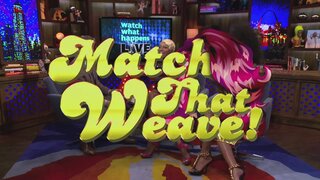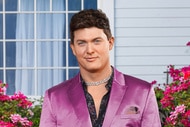
Create a free profile to get unlimited access to exclusive videos, sweepstakes, and more!
Everything You Need to Know Before Getting Hair Extensions
But really, how high maintenance are they?

Hands down, hair extensions are one of the quickest, most dramatic, and least invasive visual enhancements a person can invest in. Seriously, you can schedule an appointment on Monday, walk into the salon on Tuesday, and walk out a couple hours later looking—and more importantly, feeling—like pure fire.
That said, the world of extensions is a tangled and overwhelming one, and there are some serious pros and cons to consider before taking the Rapunzel plunge. If you don’t know what you’re doing, it’s ridiculously easy to throw your money at a product (or stylist) that’s subpar, leaving you with strange-looking hair or extensions that don’t last. We spoke to a couple hair-extension gurus for a breakdown on the different types of extensions, how to know you’re getting quality, typical costs, and how to maintain and style.
Types of Hair Extensions
First, let’s clarify the difference between a weave and an extension, as the two words are often conflated. A weave is the process of sewing hair extensions into natural hair that's been braided tightly to the scalp. Extensions can be applied in other ways, as well, including clip-in, tape, and invisible wire. We'll start by giving the DL on low-commitment extensions, and then work up to weaves.
Lisa Richards, the owner of RPZL, NYC’s first extension-only bar, said that clip-in extensions are the gateway to more traditional extensions, and recommended them as a low-maintenance option for the proudly lazy, but aspiring-glam crew. You can purchase clip-ins and apply them yourself, or have them professionally applied.
“They are most popular, especially with beginners since they’re so user-friendly and require less of a time commitment,” she said. “They’re essentially barrettes with hair attached, and they can be clipped in or out whenever you’d like.”
Another easy-to-remove option is a “hidden crown” or “hidden wire” extension. These are one-piece extensions that lay underneath your hair and, as the name implies, stay put via a wire that’s concealed by your own hair.
For a semi-permanent option, consider extensions that are taped onto the head.
“Premium tape extensions are attached by our experts at RPZL using invisible, bi-adhesive premium tape that’s undetectable to the touch,” said Richards. “They last for up to eight weeks.”
This relatively new method is a favorite among pros and extension-obsessed because it’s typically less painful, more affordable, and not as damaging as weaves. That said, there are a couple things to consider. First—though professionals do an amazing job of concealing the tape—it’s still possible tape can show when wearing your hair any way but down. Showering can also be tricky. While wearing tape-in extensions, you must be careful when conditioning your hair since conditioner will break down the glue bond and make the extensions fall out.
Yet another method—even more revolutionary than tape—is ultrasound-applied extensions.
“Sound waves are used to transform a small keratin tip from a solid to a liquid to a solid in a second flat. No damaging heat is used during the application, and they last for three months,” said Richards, who offers this service at RPZL. “The keratin bonds are lighter, tighter, and more discreet than any other hair extension on the market.”
Finally, let’s talk about weaves!
“All weaves are not created equal,” said celebrity Hairstylist Aki Hill, who’s styled Nicole Miller, Kerry Washington, and Orange is the New Black’s Vicky Jeudy. “When purchasing a weave, you want virgin, un-processed, temple-cut hair. This is the hair that is literally shaved at the temple of worship as an offering. All the hair cuticles are laying the same direction, and it has the most endurance, allowing the wearer to use it for well over a year with one single purchase.”
For the best results, it’s important that you to go to a reputable hair stylist with tons of experience in weaves. Not only will this person apply the extensions in a way that makes them lay beautifully, they’re more likely to use quality products. Weaves typically last two to three months and take about three hours to complete.
Cost of Hair Extensions
The cost of extensions varies widely depending on the type of extension you buy, whether it’s professionally applied, the city you live, and stylist expertise.
For at-home clip-in options, you can expect to pay between $20 and $50 per piece, and for at-home hidden crown and tape-in extensions closer to $100. For professionally administered tape-in extensions and weaves, prices range from $200 to $700. The ultrasound extensions we discussed earlier, a proprietary technology and technique utilized by RPZL, cost between $650 and $950.
Maintenance and Styling
Clip-in hair extensions should be removed when you sleep, when you wash your hair, and when you’re swimming. Depending on the quality of them, you can gently shampoo and condition them, and style them, as well. Refer to the instructions on your product package. Because they should be removed and reapplied every day, this type of extension can be very time consuming. However, they do make an impact, and can be saved for special ocassions or days when you randomly feel like rocking a longer length or fuller head of hair.
“Once they are clean and dry, store extensions vertically and away from direct sunlight, preferably in a dark place like a closet shelf, cabinet or dresser drawer,” Richards advised.
For tape-in, ultrasound, and weave extensions, you can pretty much style them however you want as long as you’ve invested in 100% virgin hair. This is because “they represent an authentic extension of your natural hair,” said Richards (the only exception is tape-in extensions, which shouldn’t be conditioned). “You can color, cut, and iron your hair extensions, so it really is a similar maintenance process to your normal hair with a little more time and effort since you now have both fuller and longer hair.”
Aside from at-home care, you’ll also need to hit the salon consistently.
“We recommend a visit every six to eight weeks since your natural hair growth cycle will cause tape extensions to travel away from the scalp, and with our exclusive keratin hair, we recommend every three months for a new application.”
For weaves, how often you go to the salon for a refresh depends on your lifestyle, the quality of the weave, and your hair’s growth cycle. Some people go in for a professional touch up as often as bi-weekly while others go about once a month. Your stylist will fix extensions that have become loose, re-braid hair where there’s been growth, and trim if necessary.
It’s no surprise that we see extensions everywhere, and not just on celebs! They add instant glamour to any look, and can make you feel like more bucks than all the Kardashians have combined. If you’re willing to put the effort into upkeep and maintenance, they’re totally worth it.














